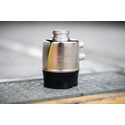Manufacturing equipment such as tank scales is typically composed of individual components. While each component is usually pre-calibrated at the factory, the combination of components (indicators, junction box, load cells, and cables) still requires calibration to operate optimally. CalFree is based on factory calibration data of the weighing sensors to address these challenges. At the same time, CalFree™ Plus for POWERCELL® load cells enables the weighing system to function and measure as soon as it is installed and connected, allowing for easy installation, fast start-up, and increased overall efficiency and uptime of the plant.
 |
CalFree™ is a comprehensive package of equipment functionality, calibration methods, and factory quality assurance that enables calibration without test weights. Our white paper covers essential topics that you need to consider when choosing the right calibration method for your tank scale.
Covered topics include:
- Initial Calibration
- Selecting the Right Calibration Method
- Influences of CalFree on Tank Calibration
- Comparison of CalFree vs. CalFree™ Plus
- Smart Calibration vs. CalFree Plus
 |
Easy Installation and Fast Start-Up
Accurate and Efficient Calibration
The manufacturing plants still face challenges as they have a tight production schedule where every minute counts and initial calibration is required for proper operation of weighing sensors. These activities present the following challenges:
- Time and effort: Calibrating large tank weighing systems is time-consuming and requires downtime, which prevents your process from running.
- Risk of errors: Manually typing in the factory calibration data of the weighing sensors carries the inherent risk of errors (typos) that can be costly.
The white paper covers solutions that can help you tackle these challenges, including accurate and efficient calibration methods for your tanks.
 |
 |
Professional Service for All Your Weighing Needs
METTLER TOLEDO offers a range of services, including installation, calibration, maintenance, and more for various industries. Our installation services provide quick and accurate setup, while our calibration services provide accuracy and reliability. We also provide customized calibration plans to fit your unique needs.
How can I simplify my tank scale calibration?
New, specially-designed or existing scales can be upgraded and easily connected to components for automation to make sure that you receive the exact amount of raw material required.
What is weightless calibration?
Weightless calibration is a theoretical calibration done without actual test weights. Read the Weightless Tank Scale Calibration White Paper to learn more.
How can I improve my tank calibration process?
You can improve your tank scale calibration process by learning about the different methods that are available in the Weightless Tank Scale Calibration White Paper. All the different options for calibrating your tank scale are explained.
What is CalFree?
CalFree™ is a combination of equipment functionality, calibration methods and factory quality assurance that enables calibration without test weights. CalFree is based on factory calibration data of the weighing sensors.
What are the influences on tank calibration that can be determined?
The influences on tank calibration that can be determined are load-cell sensitivity and local gravity variations.
What are the influences on tank calibration that are random?
The random influences on tank calibration are how load cells and weigh modules were installed on the tank, how rigid pipes are on the tank.
What is the most accurate measuring technology for critical process tanks and reactors?
Weighing is the most accurate measuring technology for critical process tanks and reactors.
When can a theoretical calibration method be used for tanks?
Theoretical calibration methods can be used when low traceability is required, like for bulk storage tanks and level control.
What is the Smart Calibration Method?
Some load cell manufacturers store calibration data in analog load cells calling this method Smart Calibration. Despite the claims, those methods are low accuracy as they cannot accommodate mechanical effects such as piping. Furthermore cables, junction boxes, safety barriers and load cell tolerances impact the calibration randomly similar to any other analog load cell system. Thus using the wrong components and unskilled installers can result in significant calibration errors.








